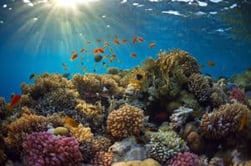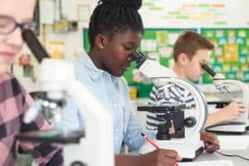Energy Transformations in an Organism Inquiry Lab
Middle School Inquiry Lab on Energy Transformations in an Organism
In this lab students will illustrate the energy transformation that takes place during digestion by using chicken livers and hydrogen peroxide. Students will observe and record the temperature change that takes place when chicken livers are placed in the hydrogen peroxide.
Each inquiry lab will contain an essential question that will drive the lesson and make students think. For this lesson, the essential question is:
- What energy transformation takes place during the digestion process?
BACKGROUND INFORMATION AND MATERIALS LIST:
Students will begin the lab by reading the essential question and background information. This can be done individually, as lab groups, or as a whole class. If you consider lab groups, you also might include some type of whole class formative checks before digging into the lab.

Materials List:
- raw chicken liver
- 100 mL of hydrogen peroxide
- dissection scissors
- thermometer
- stopwatch
- beaker
- graduated cylinder
- safety goggles
- gloves
PROCEDURE:
For this lab, students will take raw chicken livers and record what happens when enzymes, like what is in the human body, digests them. Ensuring that safety goggles are worn, students will pour hydrogen peroxide into a beaker. Before students place pieces of the liver into the beaker, students will take an initial temperature reading. Using the dissection scissors, students will take the chicken livers and cut them into small dime-sized pieces.
Once everything is set, students will take the livers and carefully place them into the beaker. Using the data table with the lab, students will place the thermometer in the beaker again and record the temperature changes during a five-minute time period at prescribed intervals. After the lab, students will dispose of materials as seen fit by their instructor.
CHECK FOR UNDERSTANDING:
At this point in the lab, students will be checked for understanding by answering questions about their findings. Here are a few that come with the lab:
- What part of the digestive system do you think the beaker and hydrogen peroxide represent?
- What change happened when the chicken liver was combined with the hydrogen peroxide?
- Where was the energy stored that caused the change?
- If the chicken liver was being digested by the hydrochloric acid of a stomach, how could the body use the energy that is released?
CONCLUSION
Students will go back to the essential question and write a CER (Claim, Evidence, Reasoning) to conclude the lab. Once completed, students will reflect back on their learning by answering the following questions:
- What type of energy is stored in food that we eat?
- Describe the energy transformation that takes place as a person eats food, jogs around the park, and continues with their everyday activities.
MODIFIED AND INDEPENDENT INQUIRY VERSIONS
All of the Kesler Science inquiry labs come with three different modification levels. Each lab is differentiated using the icons below.
STANDARDS ALIGNMENT
TEKS: 7.7A – Illustrate the transformation of energy within an organism such as the transfer from chemical energy to thermal energy.

Download Over $100 in FREE Resources
For Middle School Science
Simply create a login below and gain immediate access to a selection of our Kesler Science product line worth $100 - for FREE. There's a full version of every product type! You'll also join tens of thousands of middle school science teachers who receive timely tips and strategies straight to their inbox.





